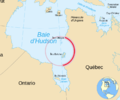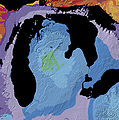Wikipedia:Wikiproject Geology/Notability
This is an essay. It contains the advice or opinions of one or more Wikipedia contributors. This page is not an encyclopedia article, nor is it one of Wikipedia's policies or guidelines, as it has not been thoroughly vetted by the community. Some essays represent widespread norms; others only represent minority viewpoints. |
Articles related to geology must adhere to the same notability guidelines as any other Wikipedia article. General guidance for assessing notability is found at WP:Notability (WP:N).
The following explains the application of notability to certain geology topics which could raise questions of just where the line between notable and non-notable topics lies. Since reliable sourcing and due weight are closely related considerations, we discuss these also in this essay.
General considerations
[edit]Open-file reports
[edit]The use of open-file reports is common in geology. These are generally preliminary manuscript reports, maps, or other products that are provided to other geologists as a source of information. It is permissible for geologists to cite such reports in their peer-reviewed papers.[1][2] However, Wikipedia editors must be cautious in their use of open-file reports as sources for Wikipedia articles. Open-file reports are best regarded as primary sources and used, if at all, under the stricter guidelines in place for such sources. Also, while open-file reports published by the U.S. Geological Survey, other national geological surveys,[3][4] or state geological surveys[5][6] are likely to have had some vetting, open-file reports have not undergone the full peer-review process required for papers published in reliable scientific journals. Editors should cite peer-reviewed publications that make use of open-file information in preference to citing open-file information directly.
Open-file should not be confused with open access. The best open journals publish articles which are fully peer-reviewed and may be cited like any other reliable source.
If a topic is not discussed other than in open-file reports, it likely lacks sufficient notability for its own Wikipedia article.
Conference abstracts
[edit]Sometimes conference abstracts are cited in support of fringe or otherwise dubious hypotheses. Conference abstracts are rarely subject to the same peer review as full papers, and should not be cited in preference to full papers published in peer-reviewed conference proceedings or scientific journals. As with open-file reports, if a topic is not discussed other than in conference abstracts, it likely lacks sufficient notability for its own Wikipedia articles.
Internet lists and databases
[edit]The Internet has a number of authoritative-sounding lists and databases on geologic topics. Some, such as GEOLEX, are provided by national geologic surveys, universities, or other reputable institutions, and these can be very useful for editors looking for links to reliable sources on a geologic topic. However, such lists and databases should not be directly cited in Wikipedia articles. Instead, directly cite the peer-reviewed papers, books, or other reliable sources from which the list or database was compiled. For example, GEOLEX links the most notable peer-reviewed publications on each stratigraphic unit in its database, and these should be cited in Wikipedia articles, rather than citing GEOLEX itself. Editors should especially refrain from citing authoritative-sounding lists, sometimes published on the website of a university or other respected institution, that are largely the work of a single author or small group of authors without verifiable peer review.
Specific topics
[edit]Stratigraphic units
[edit]As a general rule of thumb, stratigraphic units of formation rank or higher, as described in multiple independent reliable sources, are presumptively notable enough for their own article in Wikipedia. Stratigraphic units of member rank or lower will usually be described within the article for the formation of which they are a member, often as the target of a redirect. Exceptions may be made for particularly notable members, such as the Petrified Forest Member or Shinarump Conglomerate. Often such members will be raised to formation rank in part of their outcrop area, as is the case with both of these examples in New Mexico, which in itself creates a presumption of notability. On the other hand, if a formation is infrequently discussed outside the context of its encompassing group and can be adequately covered within the group article, such as the formations of the Keres Group, it may be better to redirect the formation name to the group article rather than create a stub article for the formation. As more information from reliable sources is gathered on the formation, a point may be reached where it makes sense to split the formation into its own article.
Impact events
[edit]It is now all but universally accepted that the Cretaceous–Paleogene extinction event was triggered by the Chicxulub impact event. It is likewise widely accepted that a number of so-called cryptovolcanic structures identified by previous generations of geologists (not to be confused with cryptodomes) are best explained as impact structures, particularly when shocked quartz, shatter cones, or indications of extraterrestrial chemical contamination (such as the iridium layer associated with the Chicxulub event) are found in association with the structure. Impact events tend to capture the public's attention. Humans also have a strong predilection for pattern matching, so that any round structure is likely to be eyed as a potential impact scar. Unfortunately, this means that spurious identifications of impact events are all but inevitable.
-
Nastapoka arc. Probably not an impact structure.
-
Michigan basin. Not an impact structure.
An impact structure is suspected when a structural feature shows characteristics typical of an impact scar, such as a ring of overturned beds associated with glassy breccia, in the absence of a simpler explanation, such as obvious caldera-style volcanism. An impact structure is confirmed by identifying features that are very rare other than in an impact structure, such as shocked quartz, shatter cones, and likely extraterrestrial contamination.
Wikipedia is not a journal and it is not the role of Wikipedia editors to confirm impact events. Wikipedia editors should take care not to create articles for unconfirmed impact events unless they have received significant coverage in multiple independent reliable sources. Particular care should be taken not to create articles for unconfirmed impact events that are mentioned only in conference abstracts or open-file reports by the same authors or small group of authors. Editors should also not take at face value the assessment of possible impact sites on authoritative-sounding Internet lists, even those hosted by universities, that are actually the work of a single researcher or small group of researchers with no evidence of peer review. Editors should base their assessment of possible impact sites on peer-reviewed papers instead.
Extinction events
[edit]Extinction events are an active topic of research that encompasses both geology and paleontology. As with impact events, extinction events have a particular fascination in the public mind. While many extinction events are uncontroversial, and while there is wide consensus on the cause of some of these extinctions, there is also much speculation both on possible lesser extinction events and on the causes of extinction events. When a hypothesis regarding the existence or cause of an extinction event has significant coverage in multiple independent reliable sources, it should of course be mentioned in Wikipedia. Whether it should have its own article should reflect the weight due the hypothesis.
If a hypothesis meeting the requirement of multiple independent sources is nevertheless mostly rejected by the scientific community, creating a separate article for the concept may give it undue weight. Even if the hypothesis has received widespread coverage in the popular press, it may still be better to create a redirect to the relevant section of a larger article rather than create an independent article for the discounted hypothesis.
Notes
[edit]- ^ Mashburn, Shana. "Open-File Reports". United States Geological Survey. Retrieved 14 June 2021.
- ^ "USGS Series descriptions". U.S. Geological Survey. United States Geological Survey. Retrieved 15 June 2021.
- ^ "Open Files 1999-1990". British Columbia. Retrieved 15 June 2021.
- ^ "OpenGeosciences". British Geological Survey. Retrieved 15 June 2021.
- ^ "Geologic Mapping Program: Open-File Geologic Map Series (OF-GM)". New Mexico Burea of Geology & Mineral Resources. New Mexico Tech. Retrieved 15 June 2021.
- ^ "Open File Bedrock Geology Maps". Connecticut Department of Energy and Environmental Protection. Retrieved 15 June 2021.


